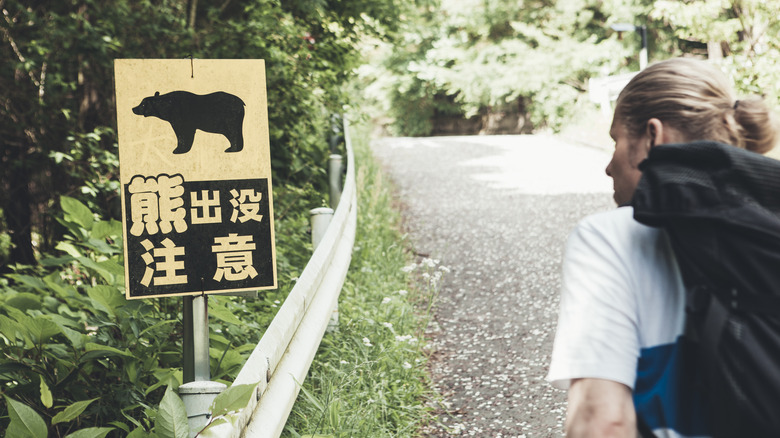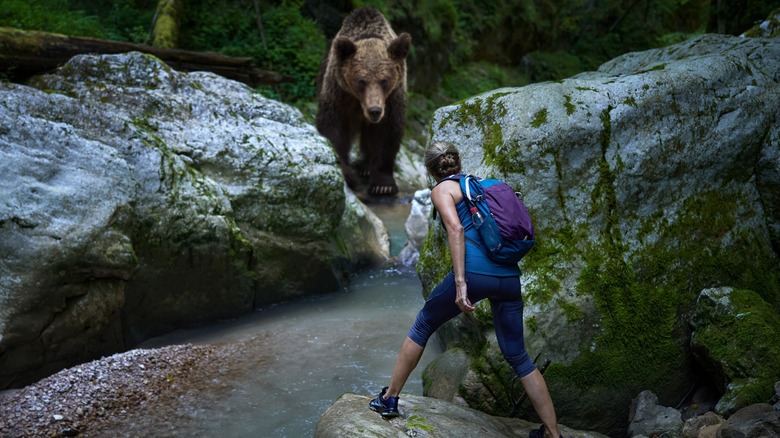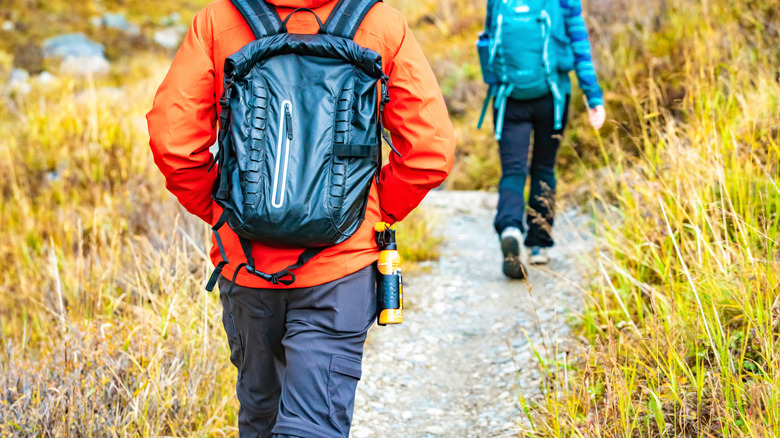What You Need To Do If You Run Into A Bear While Hiking
Hiking can be exhilarating — the views, the fresh air, the sense of adventure — but it can also be dangerous. For instance, Buckskin Gulch in the U.S. is known for its flash floods, Switzerland's Hardergrat has death-defying narrow trails, and hiking in Patagonia comes with several risks due to its remote location.
In some spots, the biggest threat isn't bad weather or a treacherous landscape — it's a four-legged predator. Bears can be found all over the world, particularly in North and South America, Europe, and Asia, and they tend to live in mountains and forests — the same places hikers gravitate to. Large portions of the U.S. and Canada are even nicknamed "Bear Country" after the black bears and grizzlies that call the region home.
Thankfully, running into bears on the trails isn't so common, given that the furry creatures prefer to stay away from humans. Still, encounters do happen, and how a hiker reacts can determine whether the bear will attack or walk away peacefully. One critical step, according to the National Park Service: Don't run. Turning your back and running might only encourage the bear to chase you, and, unfortunately, you'll probably lose to the fast-moving predator.
Stay calm and move slowly
While you shouldn't run away from a bear, you shouldn't get closer either. If the bear is unaware of your presence, make a quiet escape to safety in the opposite direction of the animal. If the bear sees you, don't stop to take a photo or approach it with food. Even if you're trying to gain the bear's trust, feeding it or moving closer may trigger its predatory instincts.
The steps you choose to take should be based on the type of bear you've encountered, but in general, the National Park Service suggests remaining calm and letting the bear know you're only a harmless human — not a hunter looking to fight. Slowly wave your arms and talk softly to avoid surprising the animal. Branndon Bargo, assistant director of outdoor adventure at Southwestern University in Texas, explained to USA Today, "How I always do it if I'm near a bear is to talk to the bear to let it know that I'm something different." If the bear remains in place, walk away slowly, moving sideways to keep an eye on the animal while creating distance. If you're cornered, leave plenty of space for the bear to escape and calmly wait until it leaves.
What if the bear approaches you?
Even though bears usually prefer to limit their contact with humans, sometimes, a bear might move closer after spotting you. While it's easier said than done, don't panic — instead, pay attention to the bear's body language. If it stands on its hind legs or approaches you slowly, it might just be curious and trying to get a better sniff.
If the animal is moving swiftly and aggressively in your direction, there are still ways to ward off trouble, depending on the type of bear. Beth Pratt, California regional executive director for the National Wildlife Federation, told CNN that the best way to respond to a charging black bear is to remain where you are, yell, and throw rocks or other objects (though not directly at the bear) to intimidate the mammal. For aggressive grizzly bears, lay on the ground in a fetal position and don't move until the bear loses interest. If the grizzly continues to show signs of aggression and you're sure you're about to be attacked, fight back using any tools available.
Bear spray is one must-have item you should always include in your hiking gear for safety. However, only use the spray to deter a charging bear, and don't apply it to your clothes, bag, or tent. A 2010 study published in The Journal of Wildlife Management found that, when used correctly, bear sprays are effective over 90% of the time.


